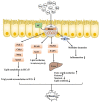The Therapeutic Effect of SCFA-Mediated Regulation of the Intestinal Environment on Obesity
- PMID: 35662937
- PMCID: PMC9157426
- DOI: 10.3389/fnut.2022.886902
The Therapeutic Effect of SCFA-Mediated Regulation of the Intestinal Environment on Obesity
Abstract
Intestinal environment disorder is a potential pathological mechanism of obesity. There is increasing evidence that disorders in the homeostasis of the intestinal environment can affect various metabolic organs, such as fat and liver, and lead to metabolic diseases. However, there are few therapeutic approaches for obesity targeting the intestinal environment. In this review, on the one hand, we discuss how intestinal microbial metabolites SCFA regulate intestinal function to improve obesity and the possible mechanisms and pathways related to obesity-related pathological processes (depending on SCFA-related receptors such as GPCRs, MCT and SMCT, and through epigenetic processes). On the other hand, we discuss dietary management strategies to enrich SCFA-producing bacteria and target specific SCFA-producing bacteria and whether fecal bacteria transplantation therapy to restore the composition of the gut microbiota to regulate SCFA can help prevent or improve obesity. Finally, we believe that it will be of great significance to establish a working model of gut- SCFA- metabolic disease development in the future for the improvement this human health concern.
Keywords: SCFA; gut microbiota; intestinal environment; metabolism; obesity.
Copyright © 2022 You, Tan, Yu, Qiu, Bai, He, Cao, Che, Guo and Su.
Conflict of interest statement
QC was employed by Guangzhou Rainhome Pharm & Tech Co., Ltd. The remaining authors declare that the research was conducted in the absence of any commercial or financial relationships that could be construed as a potential conflict of interest.
Figures






Similar articles
-
Connecting the immune system, systemic chronic inflammation and the gut microbiome: The role of sex.J Autoimmun. 2018 Aug;92:12-34. doi: 10.1016/j.jaut.2018.05.008. Epub 2018 Jun 1. J Autoimmun. 2018. PMID: 29861127 Review.
-
[Physiological patterns of intestinal microbiota. The role of dysbacteriosis in obesity, insulin resistance, diabetes and metabolic syndrome].Orv Hetil. 2016 Jan 3;157(1):13-22. doi: 10.1556/650.2015.30296. Orv Hetil. 2016. PMID: 26708682 Review. Hungarian.
-
Curcumin alleviates high-fat diet-induced hepatic steatosis and obesity in association with modulation of gut microbiota in mice.Food Res Int. 2021 May;143:110270. doi: 10.1016/j.foodres.2021.110270. Epub 2021 Mar 9. Food Res Int. 2021. PMID: 33992371
-
SCFA: mechanisms and functional importance in the gut.Proc Nutr Soc. 2021 Feb;80(1):37-49. doi: 10.1017/S0029665120006916. Epub 2020 Apr 2. Proc Nutr Soc. 2021. PMID: 32238208 Review.
-
Short-chain fatty acids: microbial metabolites that alleviate stress-induced brain-gut axis alterations.J Physiol. 2018 Oct;596(20):4923-4944. doi: 10.1113/JP276431. Epub 2018 Aug 28. J Physiol. 2018. PMID: 30066368 Free PMC article.
Cited by
-
Protective effects and potential mechanisms of fermented egg-milk peptides on the damaged intestinal barrier.Front Nutr. 2022 Dec 7;9:1068877. doi: 10.3389/fnut.2022.1068877. eCollection 2022. Front Nutr. 2022. PMID: 36570170 Free PMC article.
-
Obesity-associated inflammation countered by a Mediterranean diet: the role of gut-derived metabolites.Front Nutr. 2024 Jun 24;11:1392666. doi: 10.3389/fnut.2024.1392666. eCollection 2024. Front Nutr. 2024. PMID: 38978699 Free PMC article. Review.
-
OLED catheters for inner-body phototherapy: A case of type 2 diabetes mellitus improved via duodenal photobiomodulation.Sci Adv. 2023 Sep;9(35):eadh8619. doi: 10.1126/sciadv.adh8619. Epub 2023 Sep 1. Sci Adv. 2023. PMID: 37656783 Free PMC article.
-
Multispecies probiotic supplementation in diet with reduced crude protein levels altered the composition and function of gut microbiome and restored microbiome-derived metabolites in growing pigs.Front Microbiol. 2023 Jul 7;14:1192249. doi: 10.3389/fmicb.2023.1192249. eCollection 2023. Front Microbiol. 2023. PMID: 37485501 Free PMC article.
-
Association between gut microbiota and short-chain fatty acids in children with obesity.Sci Rep. 2025 Jan 2;15(1):483. doi: 10.1038/s41598-024-84207-4. Sci Rep. 2025. PMID: 39748068 Free PMC article.
References
Publication types
LinkOut - more resources
Full Text Sources

